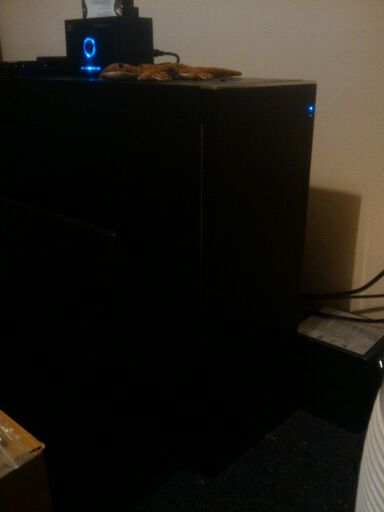As per my recent post about how I have more computers than a small country, I’ve taken the step to build a new server to run at home for all my development, backup and VM storage.
I’ve managed to condense down my server racks of stuff into a big huge tower case, taking 10 hard drives and up to a EATX server motherboard – whilst it may be pretty big, it’s nowhere near as large as a small data centre is. ;-)
Hardware specifications are:
- ASUSTek M4A78T-E Motherboard
- AMD Phenon II X4 810 CPU (4 cores, single socket)
- 12GB DDR3 RAM (planning to boost to max of 16GB)
- 4x 1TB 7200RPM SATA drives for archival/file storage. (RAID 6)
- 6x 160GB 7200RPM SATA drives for virtual machine space. (RAID 5)
- 2x 4x SATA port controller cards for PCIe-4x
- Lian Li PC-A71F chassis + additional 4x 3.5″ hotswap chassis.
- Vantec Ion2+ 600W modular PSU
- NexStar SATA docking bay + 2x 2TB 5600RPM SATA drives for external offsite backup purposes.
Software Specifications are:
- RHEL 6 Beta x86_64 (yes, you heard correctly – running beta + jethro hax to get newer version of KVM, with plans to upgrade to CentOS 6 once released)
- Full disk encryption across all drives to prevent data theft should physical access be compromised.
- KVM virtualisation -All my previous systems have been Xen, but with the newer hardware I had an opportunity to upgrade to KVM – which is great, I’m finding it far less buggy than Xen has ever been.
Cool Stuff:
- I’ve been running a number of performance tests using bonnie++ which I will post later this week – or maybe next week due to time pressures – comparing the different RAID levels and disk encryption.
- Aside from the silly side-mounted hard drives (more on this later) I’m loving the Lian Li case, they very rarely disappoint. The sleek black finish and the smooth minimalistic door on it really helps make it look sexy and awe-inspiring.
- Yes, the RAM/CPU is a little lacking, plan is to upgrade the MB, CPU and RAM to a bigger (maybe server dual socket) board later this year or early 2012.
- The whole system even with the disks and fans spinning along at a reasonable load is quiet enough for me to sleep with easily. Although, having said that, I’ll sleep through almost anything. ;-)
- Use of the multiple 160GB drives is in order to boost the I/O performance of VM disk operations by spreading load across a large number of spindles.
Not-so-cool Stuff:
- The 16GB memory limit is going to be a pain, I may have to replace the MB sooner than desired.
- I used up all my PCIe 16x slots in order to fit both PCIe 4x SATA controllers, so I’ve lost the ability to stick more video cards or other I/O controllers – need more PCIe 4x slots in my next motherboard.
- The dust filters on this version of the case appear to be more awkward to remove whilst running, unlike some of their past models.
- The side mounting hard drive case makes it difficult to close the case sides without hitting power cables or SATA cables…. using 90′ angled connectors helped for SATA data cables, but the SATA power cables are still being annoying.
I’ll have some more blog posts over the next week or so (even with pre LCA chaos) to detail some of the things I’ve learnt about Xen to KVM migration and other useful bits relating to virtualisation on RHEL 6.

